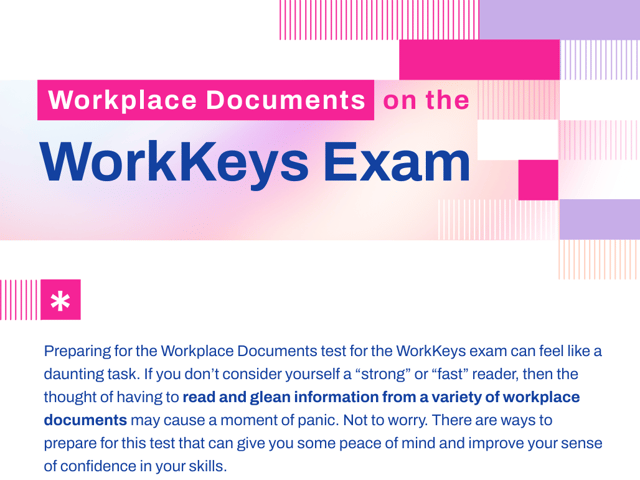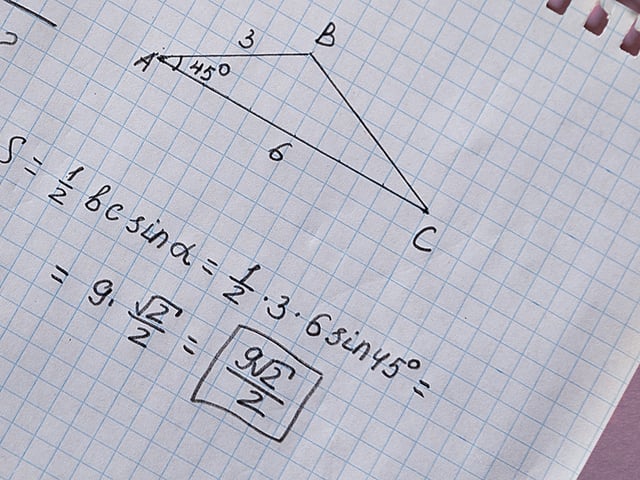
Workplace Documents on the WorkKeys Exam
The clock is ticking. Your hands are sweating. “Answer 35 reading questions in 55 minutes.” Are they kidding? Who can read that fast?
Preparing for the Workplace Documents test for the WorkKeys exam can feel like a daunting task. If you don’t consider yourself a “strong” or “fast” reader, then the thought of having to read and glean information from a variety of workplace documents may cause a moment of panic. Not to worry. There are ways to prepare for this test that can give you some peace of mind and improve your sense of confidence in your skills. And Union Test Prep can help.
What Is the Workplace Documents Test?
It’s imperative to understand that the Workplace Documents Test is much more than a reading examination; it’s a comprehensive evaluation of how you interpret, assimilate, and apply information. This goes beyond the conventional scope of reading skills.
While being able to identify the main idea, locate supporting details, and utilize context clues to understand unfamiliar terms is necessary, the test is designed to probe deeper into your cognitive abilities. It puts to test not only your reading comprehension but also your analytical skills, your ability to draw connections, and your problem-solving capabilities.
One of the key aspects of the test is assessing your ability to follow a sequence or steps in a process. This assesses whether you can recognize logical progressions and sequences, a critical skill in many workplace scenarios. It also evaluates how well you can make inferences or deduce information that isn’t explicitly stated. This requires you to draw on what you read, your general knowledge, and your personal experiences.
The Workplace Documents Test also gauges how effectively you can adapt to changing conditions and make real-time decisions — essentially how well you can “think on your feet.” This is pivotal in the ever-evolving modern workplace, where employees often need to adjust their approach based on new data or changing circumstances. Hence, this portion of the test evaluates your adaptability and resilience.
Moreover, the test measures your ability to apply information to diverse situations. This involves taking the knowledge and insights you gain from one context and applying them to solve problems in another. This is particularly crucial in the working world, where problems can often be resolved by applying concepts or lessons learned in other contexts.
A significant part of the test also revolves around applying common sense to situations and scenarios presented in the documents. This means that often, your instincts, based on your personal experiences and general knowledge, can guide you towards the correct answer. Thus, trusting your instincts becomes an integral part of the test-taking strategy.
In essence, the Workplace Documents Test is a comprehensive assessment designed to gauge your reading, critical thinking, problem-solving, adaptability, and practical application skills — all of which are vital in the workplace.
What Level of Questions Will I See?
The Workplace Documents Test is structured with questions spanning across five distinct levels of complexity. These levels represent a progressive gradation in the degree of difficulty, ranging from basic comprehension questions to more advanced queries that require in-depth analysis and critical thinking.
The first level typically involves simpler questions, focusing on basic comprehension of the text. If you find these easy to navigate, that’s fantastic! You’re on the right track. Answer these questions with care and don’t let self-doubt creep in. The apparent simplicity of these questions isn’t an attempt to trick you. If you’re progressing through these initial questions smoothly and swiftly, it’s an indicator that you’re efficiently comprehending the material.
As you advance through the test, the complexity of the documents and the corresponding questions escalates. You may encounter denser texts, multi-step procedures, or complex diagrams. This increase in rigor is purposeful, designed to challenge your higher-level thinking skills. At these stages, it’s essential to take a mindful approach. Slow down, if necessary, and reread the documents for better comprehension. Scrutinize each answer option and reflect on their implications to make an informed choice.
When tackling the tougher questions that populate the higher complexity levels, applying logical reasoning becomes crucial. Ask yourself: “What’s the most plausible course of action in this context?” or “What would logically follow from the given information?” Proactively anticipate potential outcomes or next steps based on the information provided.
These questions also require you to draw upon your prior knowledge and experiences. This involves extrapolating from what you’ve previously learned and applying it to the given context, even if it initially seems unfamiliar. This transfer of knowledge mirrors real-world situations, where we often have to adapt our skills and understanding to new scenarios.
In essence, the Workplace Documents Test takes you on a cognitive journey across varied degrees of complexity, starting from foundational comprehension tasks and leading up to advanced reasoning challenges. This structure is designed to comprehensively evaluate your ability to process, understand, and apply information across diverse contexts.
How Can I Practice Skills for the Workplace Documents Test?
Practice breeds familiarity and familiarity breeds comfort. The more exposure you can get to reading a variety of workplace documents and looking for information within them, the more comfortable you will feel when you take the exam and the better you are likely to do. So go online and do some searches for sample questions, practice tests, and reading passage examples.
As you work your way through the practice tests, if you notice there are skills that you tend to struggle with or question types you seem to get wrong more often than not, use those results to help guide your preparation. Focus on those skills. Seek out practice opportunities to engage with those kinds of texts or answer those kinds of questions, even if they’re not necessarily related to workplace documents. As you read, you’re processing information. Trust the process.
Should I Practice Taking a Timed Test?
Yes, just so the limited time on test day doesn’t affect your ability to do well. Once you feel like your skills are pretty solid, practice under the pressure of the clock. You don’t need to always do full 55-minute practices. See if you can answer half the number of questions in half the allotted time, maybe 17 questions in 25 minutes. Or, set a timer and see how many questions you are able to answer in a given amount of time. That will help you determine if your pace is quick enough to answer all of the questions in the 55-minute timeframe or if you need to work on increasing your reading speed.
There is no penalty for guessing, so try to answer all of the questions. Don’t just pick a random response, however. Try to make an educated guess by weeding out answers that are obviously wrong so you can make your selection from fewer choices.
Knowing what you’re facing by practicing sample questions ahead of time, working against the clock, and focusing on areas that you can identify as needing improvement will empower you to arrive at the WorkKeys exam ready to read and ready to succeed!

Keep Reading

WorkKeys Blog
Is the WorkKeys Test Hard?
At some point in our lives, we all come across tests we need to take to…

WorkKeys Blog
What Does Applied Mathematics Cover on the Workkeys Test?
WorkKeys offers a number of assessments and Applied Mathematics is one …

WorkKeys Blog
What Is Graphic Literacy on the WorkKeys® Test?
The term graphic literacy is used to describe a specific type of litera…